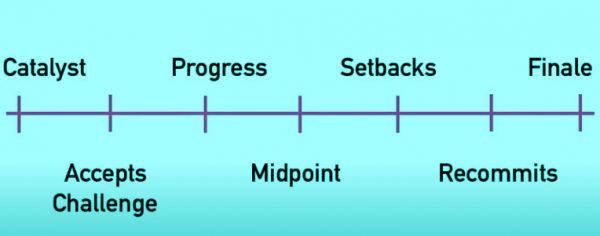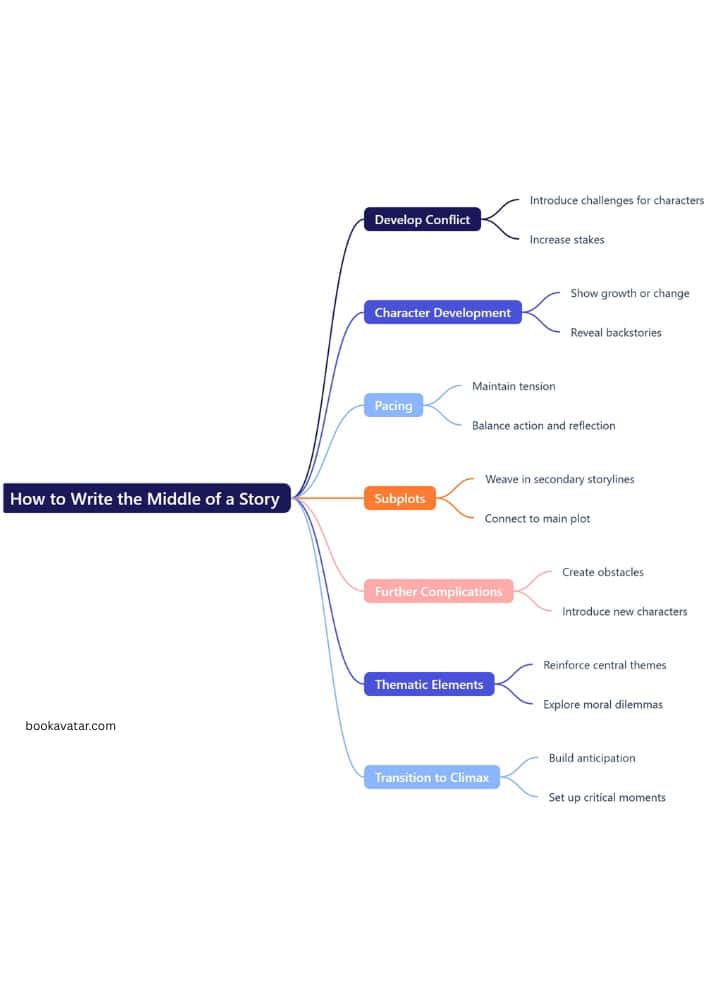
The middle of your novel is 50% to 60% of your story. Sometimes writers get the impression that the center is a third of the story, that the beginning, middle, and end concept is equal to thirds. So it’s a good chunk of the novel. If you conceptualize the book in quarters, my preferred way of thinking about story structure, the second and third quarters are both in the middle of the novel. So you’re talking about a space stretching from about 20 to 25% of the story to about 75 to 80%.
When you conceptualize the entire middle as one chunk of time without being broken up, many times, what happens is you end up with a lot of arbitrary or meaningless conflicts. That is intended to take up space, or your characters do what I call the simmer, where you introduce all of the characters and the plot elements. Then they all simmer and hang out together below the boiling point. Nothing ever goes anywhere until the climax. That’s not a very good way to write because it’s boring.
The reader won’t be as engaged, and you’ve probably realized that you’ve done. That is because the middle of your novel will feel boring or exciting about any plot point. So I find that typically with writers. It helps to conceptualize the middle as chunks and feels less daunting. Also, it can help when you’re brainstorming or editing to pick which scenes make more sense in which corner because there are differences between what should happen in the second quarter.
Structure of midpoint/mid-story
Look at the picture below, which outlines how a story in a novel typically progresses. We still need to lay out all the beats, but we’ve got the basics. There will be a catalyst, otherwise known as an inciting incident, that will make our protagonist feel like he should act.

He will accept the challenge provided by this catalyst, move forward, and begin progressing toward his goal. Then we’ve got the midpoint, and we’ll talk about that more in a little bit. The midpoint comes when he encounters bigger obstacles in pursuing his goal. He will double down and recommit digging in and giving everything he’s got to reach the finale. That’s the end of the story.
This is all a very linear, logical progression except for the midpoint. The purpose of the middle is to break up this logical, linear progression and send us shooting off in some unpredictable direction. As readers, We have no problem with it. We can’t endure it for too long or start to get bored. It’s why short stories and novellas don’t need a midpoint, but a novel does. A novel with strictly a linear progression will feel slightly saggy in the middle.
How to write the middle of a story? (Writing midpoint)
The midpoint is the second plot point, exactly the middle of your story. It’s where your character will discover new information to help resolve the conflict. It’s also the middle of your character’s character arc, where they will be presented with the truth and have to decide whether to accept it or reject it.

The character is still pursuing the goal, with the newfound information they received at the midpoint. Their allies devise another plan to attain the goal, but that plan fails. Depending on the character’s arc, they will feel defeated, and either the allies will encourage the character to keep going, or the character will become desperate. Here are 5 easy tips for writing the middle of a story. Let’s begin!
1. Create an event
When tackling the middle of your story, where should you start? You should begin with the midpoint, the middle of your second act, and the middle of your story. Create an event where your character will receive new information to help resolve the conflict. Also, the event needs to have the truth presented to the character. So that at the end of the story, the character will complete their arc.
A lot of writers struggle with the middle of the novel. They need to figure out what should go there, or they start writing it, and it’s boring. The story meanders, or they’re introducing random obstacles and conflicts to make the story take longer. So why does this happen? Why is the middle so hard to write? Usually, the issue is a lot more complicated than the middle is slow, or the writer needs to brainstorm new ideas to fill up the middle of the book.
This is a problem with how the writer perceives plot structure. I blame, at least in part, some of the education we have about story writing. A lot of the time in school, we’re told to set up a goal, then put some obstacles in the way of that goal and then have the character either achieve or fail to achieve the goal. That might work great in fifth-grade English class. But when you’re looking at a novel, only some of the time, usually that could be more complex.
The story is going to be a lot more complicated than that. Set up the story goal at the novel’s beginning, so the character knows what they’re trying to achieve and what the climax will entail, at least in part. So they know who they will fight or what they’re trying to obtain.
2. Twist the goal
If they know the basic goal at the beginning of the story and you put them on the right path at the beginning of the story. So they know the purpose, and they’re heading appropriately toward that goal. You’re going to need help to sustain an entire novel-length work.
So there are a couple of ways you can address this problem. You can give your character a different goal at the beginning of the story, one that is not the primary goal of the novel, or you can put the character on the wrong path, so they know the goal. But they need to head in the right direction toward that goal.
Most characters need to learn the story goal at the novel’s beginning. They have a goal at the story’s beginning, but it’s not the goal. It’s not the primary goal of the novel. For example, Harry Potter doesn’t know he will fight Voldemort at the story’s beginning.
If he had known that at the story’s beginning, it would have become a very different novel. Instead of casually getting his supplies, getting on the train, making friends, and playing Quidditch, he would have been training and preparing for his fight with Voldemort. All that potential for the fun setup and the introduction into the world would have been vastly different.
The goals that are going to lead to the big main story goal change at several points in the novel to create twists and turns and to make the story more exciting. What needs to be improved is putting your character on the right path with the right goal. There should be something that your character is doing wrong or some event that causes the previously correct way to become the wrong path. If your character is on the right path and they know the correct goal from the beginning, you’re left with nothing other than delays.
You’ll also need twists and turns and interesting dynamic plot points because the whole story is laid out in front of the reader. The reader knows the goal, and the character is moving toward that goal. All the reader needs to do is wait until the character gets there. That could be more exciting. It doesn’t pull the reader into the story, and that’s when you can end up with a very tedious, boring, dragging middle.
Note: To summarize, if you need to know what should happen in the middle of your novel or you’ve written the middle and it seems dull or meandering, chances are the story is too simple, and you need to add more complexity. It makes the whole writing process easier and a story much more potent.
3. Make your pinch point matter
The only difference between the first pinch point and the second pinch point is that in the second pinch point, the antagonistic force has gained considerable ground since act one. That means the disaster is getting closer to disrupting your protagonist’s plan and their entire life. You can use vicarious suspense or shared suspense here. It depends on your writing style, the pinch point, and personal preference.
There’s no one size fits all method for writing pinch points. You can make it as revealing or as cryptic as you want. Just make sure it matters, and you’re good to go.
4. Change the environments
You can change things at the middle point to give the story a different flavor. You can change the environments in which your characters are. George Lucas used always to do this in his Star Wars movies. We’d go from running around Jabba’s Palace to running around the forest of Endor, and it was a nice, refreshing change. You can change their character relationships.
An ally will become an enemy or vice versa. You can change their goals or status, but whatever it is, you want to surprise the reader. So that’s the magic of the midpoint, but it’s also the problem because it can take a lot of work to choose the perfect one.
A couple of things make sense for the catalyst and two or three possibilities for the finale. But the midpoint is a giant open sandbox, and it must be challenging to figure out what you want to build there. The most consistent advice you’ll see about how to write the midpoint is raising the stakes for the character.
When we raise the stakes, we mean that the character has more to lose now than they did before the midpoint. Perhaps you have a character trying to land a big client, and they’re afraid that if they fail, they will lose their job. They might find out that their bosses work for the Mafia at the midpoint. So it’s not a matter of losing their job. We always want to be doing this at the midpoint, but we’re going to get a little more touchy with it.
5. Show the development of your characters
Let’s review the first part of your novel’s middle or the second corner. The character reacts to what happened in the first corner for 20 to 25% to about 50% of your story. So you set up the story at the first corner at the first plot point. There should be some solidification of the stakes. After the first plot point, the character reacts. They don’t know how to respond to this new situation. They’re trying different tactics. So they’re probably messing up and failing.
Some writers are also succumbing to their character flaw or their false beliefs. So they’re making many mistakes, their reasoning could be better, or they’re only stumbling around. They have a limited amount of capability. All of this changes at the midpoint.
At the midpoint, the character gets a new piece of information, or they have some realization that allows them to move from this reactive state to a proactive state. So they become more capable and more able to move toward the climax. Their actions aren’t reacting to what happened. They’re not trying to cope with what happened as they are in the first half of the middle. They’re trying to make something happen.
Many more successes characterize this corner as the character will likely be more aggressive. There is less succumbing to their interpersonal or emotional problems overall. The character comes across as a lot more heroic and capable. They’re coming into their own, and now they’re ready to start taking action and moving forward.
To illustrate this idea of the two different quarters, I want to use The Hunger Games as an example. In the first half of the middle of The Hunger Games, right after the game start, Katniss could be doing better. She almost dies, and then she spends most of the rest of the quarter hiding from the more capable tributes. Eventually, she drops the tracker onto the career tributes below her while hiding in a tree.
So it’s not that Katniss doesn’t do anything in this corner. She tries to kill the tributes beneath her with the tracker. But it could have been more aggressive and successful. She’s punished a lot more for her actions, and she doesn’t have a strong sense of being capable and going out there and moving toward her goal.
In the second part of the middle, Katniss makes a lot more proactive and deliberate decisions. She goes and destroys the supplies of their career tributes. She makes a defiant burial for Rue, where she puts flowers on her body, which clearly signals that she is sending to the capital.
Also, she directly and aggressively kills Roos killer. It was her first direct hand-to-hand kill. So she was a lot more aggressive and a lot more capable. But the real key is that she was more proactive and more goal-oriented in the first part of the middle. In this second part of the middle, she was heading towards those supplies, ready to destroy them.
I hope you found this article helpful and gave you a better idea of the differences between the first and second parts of the middle of your novel. I made the middle less daunting to write. If you have any more questions or would like any follow-up articles, let me know in the comments.
More writing tips:
How To Write First Plot Point?
How To Write Second Plot Point?
Table of Contents
